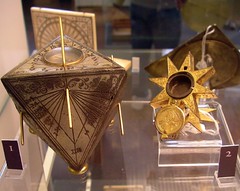Road Trip Through History: Portsmouth

H.M.S. Victory, photo courtesy of Jamie Campbell
My Own True Love and I went to Portsmouth primarily to visit the Historic Dockyards. Restored historic ships, the story of the Tudor warship the Mary Rose, the history of the dockyards themselves–it sounded right up our alley. And in fact it was. The quality of the exhibits ranged from the fabulous to the dated and dusty, but we spent a happy day there. The exhibits on the discovery and underwater excavation of the Mary Rose and the construction and conservation of Admiral Horatio Nelson’s warship, the HMS Victory were excellent. I came away with several “oh wow!” moments:
- The attempted French invasion of Britain in July 1545 was larger than the Spanish Armada. Who knew? (Attempted French invasions were a repeated theme of our trip.)
- Before mechanical watches were invented, mariners, shepherds and other peripatetic types carried pocket sundials. (Am I the only one who didn’t know this?)
 Obviously, these were the Patek Phillipes of pocket sundials. I suspect shepherds carried something a little plainer.)
Obviously, these were the Patek Phillipes of pocket sundials. I suspect shepherds carried something a little plainer.)
- A hands-on exhibit for children included a chain mail shirt sized for a ten-year-old boy. It was so heavy I could barely pick it up. I can’t even imagine putting one on without help, let alone fighting in it.
- In 1802, Nelson commissioned an oak tree plantation in the forest of Dean. Two hundred odd years later, the oak is now ready to use for repairs to the Victory. Somehow this brought the fact that timber for ships was a major issue in the days before metal ships to life for me in a new way.
But interesting as the Historic Dockyards were, the unexpected high point of Portsmouth was the D-Day Museum. Despite the fact that I read Antony Beevor’s excellent book on The Second World War a few months ago, I was chagrined to realize how little I had retained about the invasion itself–a handful of names and a few images. I certainly knew nothing about the preparations leading up to the invasion or the Portsmouth’s key role in those preparations.
The museum does an excellent job of portraying the invasion itself, but it is not “just” a military museum. A significant portion of the exhibit focuses on social history of the period, looking at bombing raids, women in the workforce, black outs, evacuation and rationing as experienced in Portsmouth. I was particularly taken by the oral history element of the museum: the museum not only provided book after book of first hand accounts for the visitor to read, it also played recordings of those accounts in the relevant sections of the museum. My favorite line was from a woman working in a munitions factory:
“They used to tell you that you couldn’t do it, but at the same time there was no-one else to do it…You had to get it done.”
Sing it, sister.




